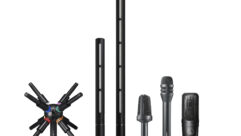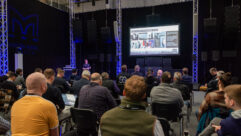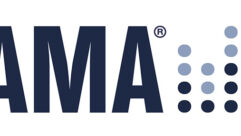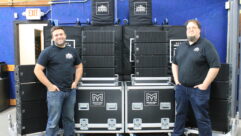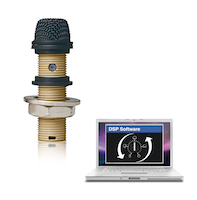

CAD Audio-Astatic Commerical 2220VP
Jun 6, 2011 5:16 PM,
by John McJunkin
An IP-controllable button-style
continuously variable mic.
CAD Audio-Astatic Commercial 2220VP
Variable-pattern microphones are nothing new. The very physical nature of condenser mics facilitates the possibility of patterns ranging from omnidirectional to figure eight and all cardioid points in between—hyper-, super-, and plain vanilla. Mic manufacturers have made multiple-pattern mics available over the years, but to the best of this author’s knowledge, none have ever offered a continuously variable pattern mic specifically to the install/contractor market. This would be a desirable development, offering maximum control over the way mics capture the acoustics of a boardroom, for instance. Imagine a boardroom with 12 chairs around the table, each with a gooseneck mic. In order to capture all the voices effectively and in an orderly fashion, it would initially seem that you’d want cardioid mics all the way around, possibly even pretty tight cardioids. Unfortunately, human beings are animated creatures that may move while they speak, bobbing and weaving in and out of our cardioid pattern. Why couldn’t we just solve the problem by using omnidirectional mics all the way around the table? Well, there are two challenges presented by this approach: One is that omni mics not only pick up voices in all directions, but they also pick up noise and room ambience in all directions—the noise floor comes up and intelligibility goes down. The other issue is that since the polar patterns of adjacent microphones overlap, flangey/swishy phase incoherencies will be heard swirling around—not pleasant or desirable.
Clearly, the solution is to use cardioid mics on the less animated folks at the table and omni mics on the disco dancers. Unfortunately, the knowledge of who is which type may not be clear prior to meeting time. A remotely controlled continuously variable pattern microphone would present a solution to this challenge. As the degree of speaker animation is determined, mics could be optimized to limit noise and room ambience and to maximize the level and consistency of the signal captured by each mic. The steadfast and stoic get a nice tight cardioid, and the kinetic and cavorting get a broader pattern as necessary.
CAD Audio-Astatic Commercial introduced a couple of continuously variable pattern mics in recent years: one intended for podium (GN15VPD) or boardroom use (930VPL), the other intended essentially as a choir mic (1700VP). I’ve played with both and found them both to be very useful—the choir mic in particular, which not only grants control over pattern but also sounds quite good. Now Astatic has introduced two new variations on the variable pattern theme, a hanging mic (2600VP) and a button-style boundary mic (2220VP) for install into boardroom tables. In addition to the new mics, Astatic also introduced something that I deem to be a bit of a blockbuster: control of the continuously variable pattern via IP. To be sure, just having non-IP system management from a control surface in the same room is very nice and the more likely scenario, but the fact that control can be achieved via IP over long distances should put a smile on the face of contractors everywhere. I’ve been speculating with friends lately about a future in which hotels and conference centers can consolidate multiple systems in multiple rooms, with literally a single professional at a centrally located control surface babysitting for feedback and other similar issues. Clearly, this type of technology moves us forward a few notches toward this future.
The Astatic 2220VP is cylindrical in shape, 3.35”x1.1”, with a black wire mesh at one end—the part of the mic intended for exposure to the acoustical environment. This flat black business end of the mic is just a bit more than 1in. in length, so upon installation, it’s pretty unobtrusive. The remainder of its enclosure is a threaded shaft that facilitates installation with a washer and nut. At the other end of the cylinder is the mic’s XLR connector. The published frequency response of the mic is 90Hz to 17kHz, and considering the small condenser element, the rolled-off low end is no surprise. It’s actually an important feature, rather than a bug, particularly for installs in which the mic is table-mounted. In addition to their dancing skills, our boardroom speakers also boast percussion talents, and the thump and bump of the table is diminished by the rolled-off response of this mic. Sensitivity is published as -32dBV @ 1Pa, and its signal-to-noise ratio is a really quiet 18dB of self-noise (A-weighted). The mic can take a maximum input SPL of 120dB (yielding an inaudible 1 percent THD), and in consideration of the fact that it’s intended for boardroom applications and not heavy metal guitar amps, this is just fine. The mic looks for 4mA of phantom power at 12V, 24V, or 48V, and its output impedance is 120Ω, allowing multiple microphones to be used on most standard audio mixers with phantom power. The mics have been designed to reject RF interference such as cell phones and two-way radios, and do so effectively.
1
CAD Audio-Astatic Commerical 2220VP
Jun 6, 2011 5:16 PM,
by John McJunkin
An IP-controllable button-style
continuously variable mic.
I received one of Astatic’s 2220VP mics to play with, along with a Biamp Systems Nexia digital signal platform system intended for use as a controller. A system like this is necessary for control over the variable pattern. Your computer is not necessary unless you plan on controlling via IP, otherwise the mic or mics can be directly controlled without the computer. I was able to plug in and get the system networked very easily. Astatic makes control blocks for the Audia or Nexia DSP system available via the Internet (or on a CD-ROM), and with these installed into the software, IP control is quite simple. The output of the mic is divided necessarily into two tails, which takes up two input channels in your system. Changing the relative input level of each of these two channels is what determines the mic’s pattern. Astatic specifies the following patterns as resulting from an initial setting of 0 on the A channel and 40 on the B channel to the reverse of that (40 on the A channel and 0 on the B channel): omnidirectional, sub-cardioid, uni-directional wide, cardioid, uni directional tight, supercardioid, hyper-cardioid, and figure eight. It’s quite a simple and effective mechanism.
As has been my prior experience with Astatic’s variable pattern mics, the 2220VP sounds very good. It is more than sufficient for capturing speech in a business or house-of-worship environment, which is no surprise presuming that it uses the same element as the excellent Astatic choir mic I’ve used before. The capacity to continuously vary its polar pattern via IP is a very powerful convention that can nicely enhance the quality of the audio delivered by the professional. I’d definitely recommend looking into it.
John McJunkin is the principal of Avalon Podcasting in Chandler, Az. He has consulted in the development of studios and installations and provides high-quality podcast production services.
Product Summary
- Company: CAD Audio-Astatic Commercial
www.cadaudio.com - Product: 2220VP Microphone
- Pros: Unique ability to remotely vary polar pattern
- Cons: Two channels of input taken up by each mic
- Applications: Boardroom, house-of-worship, installation market
- Price: $499
Specifications
- Operating Principle: Condenser
- Polar Pattern: Continuously variable
- Frequency Response: 90Hz -17KHz
- Sensitivity: -32dBV (25mV) @ 1 Pa
- Impedance: 120Ω
- Maximum SPL: 120dB, 1% THD, 1KHz
- Self Noise: 22dBA
- Power Requirements: P12, P24, P48, 4mA
- Connector: 3-pin XLRM-type
2



